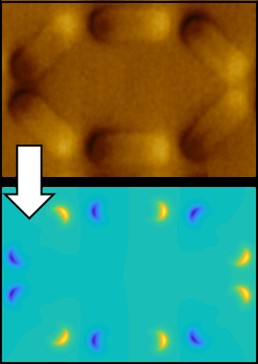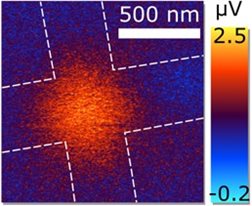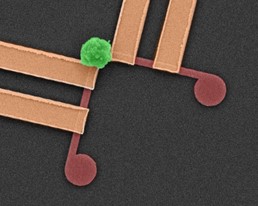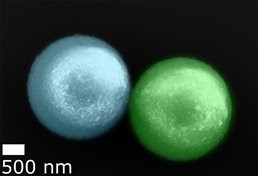The ability to quantifiably measure nanoscale magnetic field distributions currently eludes the field of metrology. Industries, including magnetic sensing, information technology, biomedicine and consumer electronics, would benefit from traceable and reliable measurements of magnetic fields and flux densities on the nanoscale.
 Magnetic force microscopy (MFM) is a popular technique for nanoscale magnetic analysis due to its nanoscale spatial resolution and ease of use in standard conditions. We conduct advanced nanoscale magnetic measurements by MFM using specialised scanning probe methods including magnetic scanning gate microscopy, in situ field MFM and electrostatically-compensated MFM.
Magnetic force microscopy (MFM) is a popular technique for nanoscale magnetic analysis due to its nanoscale spatial resolution and ease of use in standard conditions. We conduct advanced nanoscale magnetic measurements by MFM using specialised scanning probe methods including magnetic scanning gate microscopy, in situ field MFM and electrostatically-compensated MFM.
Quantitative measurements are routinely conducted by calibrating MFM probes from different methods; such as Graphene Hall sensors, and calibrated stray-field reference materials (including continuous films, patterned structures and current-carrying nanowires).
Understanding the probe’s magnetic profile allows us to acquire quantitative magnetic measurements from unknown samples within a specified uncertainty budget.
 Calibration of individual nano-objects (including MFM probes, microbeads and nanoparticles) can be achieved by using epitaxial graphene Hall sensors and scanning gate microscopy.
Calibration of individual nano-objects (including MFM probes, microbeads and nanoparticles) can be achieved by using epitaxial graphene Hall sensors and scanning gate microscopy.
The high sensitivity of Hall sensors makes them ideal for measuring such fields. From the catalogue of scanning probe techniques at our disposal, we can overcome common sources of errors associated with imaging current-biased devices in order to accurately determine stray magnetic fields at the nanoscale.
 Significant developments in magnetic nanoparticles (MNPs) has primed them for biomedical applications. In particular, the possibility to manipulate and detect individual MNPs is of great interest due to their potential for lab-on-a-chip applications.
Significant developments in magnetic nanoparticles (MNPs) has primed them for biomedical applications. In particular, the possibility to manipulate and detect individual MNPs is of great interest due to their potential for lab-on-a-chip applications.
We’re working towards single MNP characterisation and detection. We isolate MNPs to characterise their intrinsic magnetic properties by, for example, magnetic scanning gate microscopy which has allowed us to test a new generation of single MNP detectors. These devices, based on magnetic domain wall (DW) dynamics, have the capability of acting both as a sensor and as a means to manipulate MNPs.
We’re working towards single MNP characterisation and detection. We isolate MNPs to characterise their intrinsic magnetic properties by, for example, magnetic scanning gate microscopy which has allowed us to test a new generation of single MNP detectors. These devices, based on magnetic domain wall (DW) dynamics, have the capability of acting both as a sensor and as a means to manipulate MNPs.
We are working to improve standardisation within the field of magnetic nanoparticles (MNP) manufacturing and measurement. Furthermore, we are involved in the work of technical committee ISO/TC 229 contributing to the drafting of a new ISO Technical Specification (ISO 19807) on the characterisation techniques for suspensions of magnetic nanoparticles.
manufacturing and measurement. Furthermore, we are involved in the work of technical committee ISO/TC 229 contributing to the drafting of a new ISO Technical Specification (ISO 19807) on the characterisation techniques for suspensions of magnetic nanoparticles.
Our research and measurement solutions support innovation and product development. We work with companies to deliver business advantage and commercial success.
Contact our Customer Services team on +44 20 8943 7070